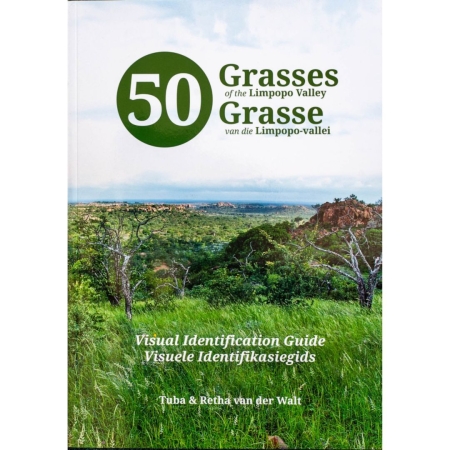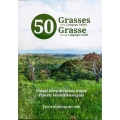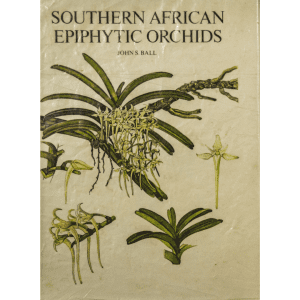Book Review by Shobie Arnoldi
This guide is intended for the non-professional to identify
50 common grass species in the Limpopo Valley area in
the north of the Limpopo province, South Africa, but also for
anyone interested in grasses.
The layout of the guide is simple and practical with full-colour
scanned images of the grass species involved. A section
illustrating the structure of the grass plant at the back of the
guide is critical, and visually explains some of the terminologies
discussed in the guide. The guide largely attempts to provide an
aid to help visually identify grass species, rather than a key to
their specific identification with further elaborations.
However, users of this guide should keep in mind that
visual similarities between images in this guide and grasses
in the veld are not necessary an accurate means of species
identification, as there are visual similarities among many of
grass species. Therefore, this guide cannot be used as an
objective definitive identification guide although it would be
most accurate when used in the Limpopo Valley. Additional
reference work must be done for confirmation, such as grass
books, the internet and/or experts.
The grass species are grouped into 13 groups in this guide,
based on their inflorescences or spikelet appearance, which
provides an easy distinctive way of identifying grasses. The guide
succeeds in quickly grouping the different groups of grasses in
this way for faster identification. However, I would like to see on
each page which group I am working on so that I could determine
where to stop making comparisons for identification.
All images in the guide were scanned against a white
background that shows the grass parts more clearly, except
for Stipagrostis uniplumis and S. hirtigluma, which have
a dark background, understandably. The problem with the
white background is that certain obvious characteristics of
certain grass species, such as hairiness and awns, are not
clearly visible. For example, the villous and ciliated spikelets
of Schmidtia pappophoroides with their five awns, as well
as their pubescent leaf sheaths and lamina, do not appear
clearly. Likewise, useful identification features, such as the
densely gland-tipped hairs of Enneapogon cenchroides on
the leaf sheaths are also unclear. My suggestion would be
to display such features against a dark background and not
the whole grass as such. Although it is mentioned in the
guide that not all the characteristics of the grass species are
focussed on, it is nevertheless important to point out certain
characteristics that are distinctive, which are often obvious to
the observer in the field.
It is also a good choice that the scientific names of the
grass species are provided as headers, because they are the
internationally standardised way of naming, and as common
names can differ from area to area for the same species.
The fact that relevant information of each grass species is
discussed in both Afrikaans and English is very advantageous.
For the purpose of this guide, the correct information is used,
such as whether the plant is annual or perennial, growth form,
soil preferences and grazing value. Distinctive features are
also mentioned in certain species, such as the boat-shape
leaf tips and the spikelets’ tendency to cluster in Heteropogon
contortus. Such information is sometimes very important and
supports the visual identification of a species.
The actual size of the inflorescence with the spikelets
displayed is a very good tool for identification, providing
greater certainty. It is also very relevant that this guide shows
the different appearances that the inflorescences can take as
one would encounter them. However, I would like to see the
inflorescence in relation to the vegetative part of the grass
plant, on a smaller scale, of course. Its size and shape can also
greatly contribute to the easy identification of grass species.
Overall, I think this guide succeeds in helping the
non-professional and beginner in grass identification, especially
in the Limpopo Valley area, because specialised botanical
terminology is not used and the focus is based on the visual
observation. The layout, grammar and descriptions are of a
good standard. It is also a useful guide for the more advanced
grass experts, because there should be grass species that they
have not encountered yet.
I would recommend this guide to people living in or visiting
the Limpopo Valley, especially landowners and anyone
familiar with or interested in grasses in general, and beginners
embarking on the thrilling journey of grass identification.
Book Review
50 Grasses of the Limpopo Valley – Visual identification guide
By Tuba and Retha van der Walt
2021, Silverhills Seeds and Books, Bergvliet: www.silverhillsseeds.co.za
112 pages, softcover, English and Afrikaans
ISBN 978 0 620 97165 2
Price: R142.00
Shobie Arnoldi
TopVeld CC, Ermelo, South Africa
Correspondence: topveld123@gmail.com








